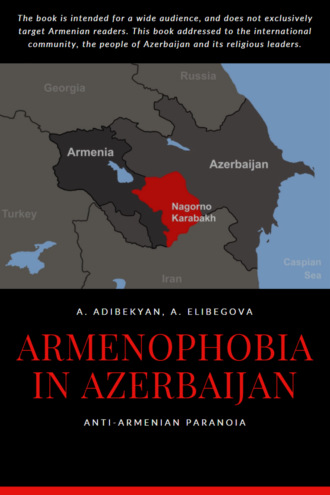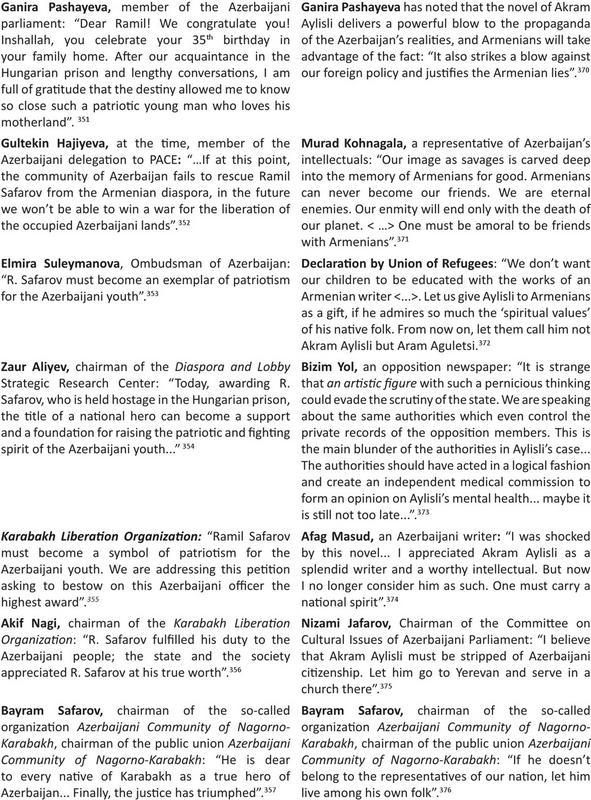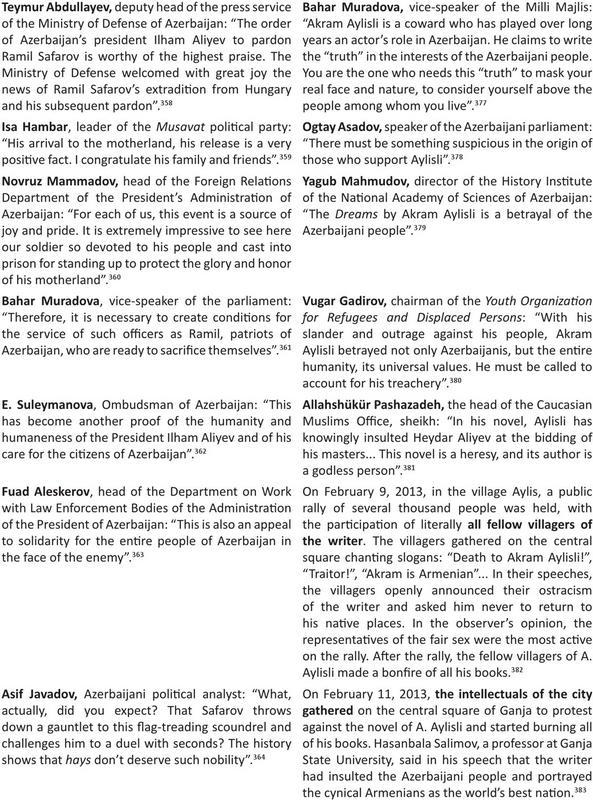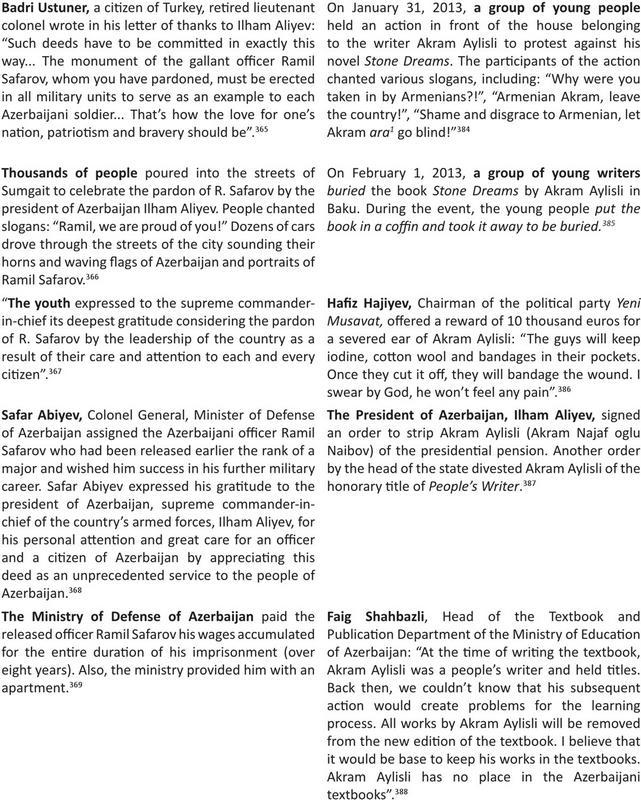 полная версия
полная версияArmenophobia in Azerbaijan
Extract from an interview by a famous Azerbaijani actress, Shukyufa Musayeva who tells the story of her involvement in the fighting over Karabakh: I was wounded in the blink of an eye. We were waging a battle, and two of our askers381 burnt down to death. Later, I was told that I, profusely bleeding, screamed: “Commander, don’t let the boys burn to death!” As I passed out, I slipped into a clinical death. I was taken to Baku in a helicopter to the Semashko hospital. I was hurt beyond recognition; fragments were all over my body and especially on my face. They stitched together a wound on my forehead, but it would not heal. As I was already going through the recovery period, a doctor tried to pull out my frontal bone using a pair of tongs. I didn’t feel anything, I only saw another doctor enter the room, give him a slap in the face and take him away with words: “What is it? Do you want to make her miserable?”
It is only now that I realize that this doctor either did somebody’s bidding or was Armenian. Later, I read that the human memory is contained in the frontal bone382. I don’t know the reason, but this Armenian doctor in his attempt to pull out my frontal bone wanted to erase and remove my memory.383
Occult practices hold a special place in unmasking the subversive role of Armenians. Parapsychologists and psychics have joined the fight against the pernicious Armenian influence and claim in dead earnest that “Armenia is launching hostile magical assaults against Azerbaijan through releasing energy waves to induce depression, aggression, despondency, vindictiveness, etc”.
From an interview given to Bizim Yol by a phytotherapist and parapsychologist Tunzala Bayramova: “Azerbaijan is in a state of war with Armenia, and the war is waged not only using weaponry, but also over various other channels. For instance, those who have lost their homes are aggressive, with problems rising between them and the locals because of their inability to find common ground; contradictions also rise between rural and urban populations. All of it bears the impact of our enemy’s magic manipulations. On the other hand, I am more concerned with the lack of love in our society. People feel a void that becomes filled with mercenariness, greed and avidity intrinsic to the period of transition”, stated T. Bayramova.
The parapsychologist assures that Armenia is mounting alleged magical assaults against Azerbaijan through releasing energy waves which induce heavy depression, aggression, despondency, vindictiveness, etc. “There, sorcerers comprise 20 % of their population. Each country has its own political laboratories and scientific centers studying magic, parapsychology and extrasensory powers; these centers do the bidding of the country’s leadership. Regretfully, Azerbaijan is an exception and becomes target of such attacks”, assures the phytotherapist and parapsychologist.384
Judging by the publications appearing in the Azerbaijani press, Azerbaijanis are quite superstitious and fervently believe in psychics, witches and sorcerers. The sector of occult services in Azerbaijan accounts for an approximate turnover of 200 million manats.385 With this in mind, there can be no doubts that the parapsychologists’ message is surely to drive home and be blindly accepted and added to the armory.
The Azerbaijani website Vesti.az: An unknown person called the 112 service of the Ministry of Emergency Situations of Azerbaijan and reported that Armenians had attached a bomb to his back.386
A significant share in the theory of conspiracy and subversive action goes to claims of a “classic” terror at the hands of Armenians (kidnapping, terror acts, etc.). It must be noted that Azerbaijan has publicly announced that “in connection with threats from ASALA terrorist organization” all itineraries of Azerbaijani officials will be kept secret.387 However, after a while, the publication of information on the movements of officials resumed.388
The hand of Armenians, represented by a phantom Armenian named Maukamyan, was unveiled in nothing short of orchestrating the collapse of the Soviet Union as well as a “series of terrorist acts”, including the Black January389.
Extract from an interview with Anatoly Fedorenko, the author of the book Black January who lives in Ukraine and is an eyewitness of the bloody events of January 1990 in Baku: With my hand on Quran, I swore an oath by Allah to politically revenge the terrorists whatever it took. In a short while, we will be mounting an action against Gorbachev. My comrades are conducting an investigation that has preliminarily revealed that Mikhail Sergeyevich Gorbachev was recruited in 1979 by Maukamyan, a resident agent of Armenian origin of the American special services. It was him who coaxed Gorbachev into further collaboration. Gorbachev was given an instruction on how to cause the collapse of the Soviet Union in disguise of the Perestroika; in fact, he was perpetrating a series of terrorist acts against the ordinary and peaceful people. In 1990, Azerbaijan saw events that later came to be called as Black January.390
The figures of the Azerbaijani establishment can be diagnosed with a clear case of cause and effect disruption. Fully aware of grave domestic problems faced by their country, they are concerned with finding out if such problems were brought about by an Armenian or the fact that Armenians might learn and spread the word of their problems.
In his statement delivered on the Solidarity for Karabakh forum held in Baku, the journalist Azer Hasrat exhorted his colleagues to stop their criticism of the authorities and their report of Azerbaijan’s domestic problems as Armenian specialists were reading and re-circulating that information.
I have started my speech with a phrase: “Watch out! We’re being overheard. After that, I said that statements pronounced in this room and appearing in the Azerbaijani press are very closely followed in Armenia. Armenians draw from our newspapers all negative opinions about our army or country, translate and disseminate them across the world because this serves their interests. Therefore, we must be careful in our statements. Such meetings cannot be used to air grievances in respect of high-ranking officials and the president”, reports the Azerbaijani journalist.391
Attempts to explain Azerbaijan’s ongoing destructive processes by external forces are quite clear. Here, a protective mechanism is activated representing an instinctive process intended to minimize negative experiences. The existence of the problem itself is already a source of such experiences, while realizing own guilt and the onus it carries represent a factor that multiplies negative sentiments and exacerbates the oppressed minds.
12. Ramil Safarov vs. Akram Aylisli: avatars of good and evil
The philosophical categories of the good and evil and the quest for choosing between them represent the basis of the human civilization. These categories rest on the essence of the humanity at large and individuals in particular.
Good is the central category of any moral system.
The good is the supreme moral value, and to do good is the main regulating force of a moral line of conduct.
The evil represents the antithesis of the good. It is the anti-value, i.e. something incompatible with the moral line of conduct.
Good is the goal that must be attained, cultivated and created. The evil, in its turn, is something that one ought to dissociate oneself from.
The good and evil do not stand on equivalent footing. The evil is secondary to the good; it is only the reverse side of the good, a deviation from it. It is for a reason that the God (good) in Christianity and Islam is omnipotent, while the devil (evil) is solely capable of abetting the violation of God’s commandments by some individuals.392
Not only deeds can be attributable to the category of the evil. The evil can be used to describe the character of various objects and phenomena which elicit negative sentiments of taste, smell, pain, bad experience and state. The good represents the goal that must be attained, cultivated and created. The evil is something that one ought to dissociate oneself from, refute, neutralize and overcome. A. Voloshina, in her drawing of a borderline between the good and the evil, wrote: “The good along with pleasure, beauty, truth and benefit represents the main component of the welfare, i.e. an absolute goal that cannot serve as a means to achieve any other end, while the evil encompasses suffering, lie, harm, deformity and immorality”.393 Spinoza analyzed the traditional ethical categories of good and evil in correlation with the concepts of pleasure and pain. Thus, the good, inasmuch as it represents benefit and use, is perceived positively (pleasure), while the evil, inasmuch as it inflicts damage and is of no use, is appraised negatively (pain).394
Awareness of the essence of good and evil, understanding the extent of their antagonism and the ability to differentiate between them underlie the public morals manifested through moral judgments.
Moral judgments are judgment (statements) which express the moral appraisal or norm or prescription.395
The moral appraisal represents a set of structured judgments and significant priorities based on the internal needs of the society developed through tradition, culture and code of conduct. Values are perceived and appraised as moral good within the confines of established rules and traditions.
After series of studies, the philosopher Joshua Knobe396 revealed the dependence between moral judgments and the perceptions of the world. The Azerbaijani society provides a sufficiently illustrative example of this statement, with its shaping of quite specific moral judgments and the surrounding world viewed through the prism of Armenia and Armenians. This gives rise to a distinctive Knobe effect397:
An Azerbaijani who ran over a pedestrian is bad and guilty, but if the pedestrian turns out to be Armenian, then the Azerbaijani is not guilty and did a right thing by running over this pedestrian.
An Azerbaijani killed a man; he is a criminal, but if it turns out that his victim is Armenian, then he is a hero and did a right thing by killing the man. An Azerbaijani stole something; he is a thief and criminal, but if the victim turns out to be Armenian, then he did a right thing as the Armenian deserves it. An Azerbaijani girl gets married amid wishes of happiness and joy, but if it turns out that the groom is Armenian, then she is a reprobate and apostate who deserves punishment.
The moral evil is defined in contrast to the moral judgment and moral appraisal as going beyond socially established value benchmarks and the breakdown of rooted public morals. Each society shapes its own perception of the good and evil in line with its traditions and set of values. At the junction of good and evil with slight shifts to either side, an extensive field of action opens up for ideology and propaganda. A universal technique employed by the propaganda of all countries consists in a clear delimitation between the world of good implied to include the world of the subject and the world of evil encompassing the object. The denigration of the latter occurs through comparison with animals, spawn of hell or subhumans depending on the world view.
“Our duty is to foment hatred for evil and invigorate the thirst for beautiful, kind and just things”. The author of these words is Adolf Hitler.
Similar notions of good and evil are cultivated in the society of today’s Azerbaijan where the evil is represented by Armenians, and the good is represented by those who wage a struggle against them “by all available means”. This phenomenon is showcased by Ramil Safarov, a personification of the “good”, who hacked a sleeping Armenian officer with an axe,398 and Akram Aylisli, a personification of the “evil”. In his novel entitled The Stone Dreams, the author draws parallels between the massacre of Armenians in Nakhichevan in early 20th century and the pogroms of Armenians in Baku of the late 20th century through the prism of his own feelings.



351. «İnşallah, Azərbaycanda görüşərik!!! -Qənirə Paşayevadan Ramil Səfərova təbrik. Modern.az. 25.08.2011. http://modern.az/articles/16595/1/ (az)
352. «Зеркало», 28.02.2004, newspaper, (rus)
353. Ibid
354. Ramil Səfərova Milli Qəhraman adı verilsin. Zaur-Aliyev.info. 16.12.2011 г. http://zaur-aliyev.info/?p=269 the original was removed from source, a cashed copy can be found here: http://peeep.us/982db60a (az)
355. ООК предложила присвоить медаль «За отвагу» Рамилю Сафарову. Day.az. 22.02.2005. http://news.day.az/politics/20906.html (rus)
356. Акиф Наги: «Азербайджан способен освободить Карабах так же, как освободил Рамиля Сафарова». Salamnews.org. 31.08.2012. http://ru.salamnews.org/ru/news/read/162037/akif-nagi-azerbaydan-sposoben-osvobodit-karabax-tak-je-kak-osvobodil-ramilya-safarovanbspnbsp/. the original was removed from source, a cashed copy can be found here: http://peeep.us/3fd152bf (rus)
357. Байрам Сафаров: «Армяне должны понять, что освобождение Рамиля Сафарова – очередная победа Азербайджана». АПА. 31.08.2012. http://ru.apa.az/news/230232 (rus)
358. Указ президента страны о помиловании Рамиля Сафарова достоин наивысших похвал – представитель Минобороны. Salamnews. 31.08.2012. http://ru.salamnews.org/ru/news/read/162054/ukaz-prezidenta-strani-o-pomilovanii-ramilya-safarovanbspdostoin-naivisshix-poxval-ndash-predstavitel-minoboroninbspnbsp, the original was removed from source, a cashed copy can be found here: http://peeep.us/b0c082dd (rus)
359. Достойны похвалы те, кто приложил усилия для экстрадиции Рамиля Сафарова в Азербайджан – Иса Гамбар. Salamnews. 31.08.2012. http://ru.salamnews.org/ru/news/read/162060/dostoyni-poxvali-te-kto-prilojil-usiliya-dlya-ekstradicii-ramilya-safarova-v-azerbaydan-ndash-isa-gambarnbspnbsp/. the original was removed from source, a cashed copy can be found here: http://peeep.us/fad2ac8e (rus)
360. Новруз Мамедов: «Благодаря решимости и воле Президента Азербайджана Рамиль Сафаров доставлен в Азербайджан». Newtimes.az. 31.08.2012. http://www.newtimes.az/ru/r0/s4/d8/2/n467/Новруз-Мамедов%3A-«Благодаря-решимости-и-воле-Президента-Азербайджана-Рамиль-Сафаров-доставлен-в-Азербайджан» the original was removed from source, a cashed copy can be found here: http://peeep.us/64c57d6a (rus)
361. Двойные стандарты в вопросе освобождения азербайджанского офицера вызывают сожаление – вице-спикер. Trend. 03.09.2012. http://trend.az/news/politics/2061197.html (rus)
362. Омбудсмен встретилась с Рамилем Сафаровым. 1.news.az. 03.09.2012. http://1news.az/society/20120903104550617.html (rus)
363. Фуад Алескеров: «Возвращение Рамиля Сафарова в Азербайджан стало возможно лишь благодаря личному авторитету президента Ильхама Алиева». АПА. 31.08.2012. http://ru.apa.az/news/230240 (rus)
364. Эксперт: Передача Рамиля Сафарова Азербайджану – это следование обычной практике в международных отношениях. Aze.az 01.09.2012. http://aze.az/news_ekspert_peredacha_ramilya_81557.html (rus)
365. Турецкий полковник обратился к президенту Азербайджана для установления памятника Рамилю Сафарову. Apa.az 18.09.2012. http://ru.apa.az/news/231429 (rus)
366. В Азербайджане празднуют освобождение Рамиля Сафарова – ВИДЕО. Day.az 01.09.2012. http://news.day.az/society/352460.html (rus)
367. Молодежь Азербайджана выразила благодарность президенту страны за помилование Рамиля Сафарова. Salamnews. 31.08.2012. http://ru.salamnews.org/ru/news/read/162074/molodej-azerbaydana-virazila-blagodarnost-prezidentu-straninbspnbsp/. the original was removed from source, a cashed copy can be found here: http://peeep.us/9dc54f79 (rus)
368. Освобожденному азербайджанскому офицеру Рамилю Сафарову присвоено звание майора. Trend. 01.09.2012. http://trend.az/news/society/2060860.html (rus)
369. Минобороны Азербайджана предоставило Рамилю Сафарову квартиру. Trend. 01.09.2012. http://trend.az/news/society/2060909.html (rus)
370. В Милли Меджлисе обсудили вопрос по поводу Акрама Айлисли. Baku.ws. 02.02.2013. http://baku.ws/index.php?newsid=17897 (rus)
371. Murad Köhnəqala yazır. Kulis.az. http://kulis.az/news/3980 (az)
372. Qaçqınlar Cəmiyyəti Əkrən Əylisli ilə bağlı təkliflər irəli sürdü. Modern.az. 04.02.2013. http://modern.az/articles/34118/1/ (az)
373. Əkrəm Əylisli ilə bağlı daha bir qalmaqal. Bizimyol. 19.02.2013. http://bizimyolinfo.com/?sehife=1&xeber=7409 (az)
374. Afaq Məsud: ‘Əkrəm Əylislinin bu əsəri ədəbiyyatımıza qara ləkədir’. Azxeber.com. 30.01.2013. http://azxeber.com/news/27186.htm (az)
375. Азербайджанские депутаты осудили скандальный роман Акрама Айлисли. Trend. 01.02.2013. http://trend.az/news/politics/2114547.html (rus)
376. Байрам Сафаров: «Акрам Айлисли играет чувствами людей, потерявших близких или ставших инвалидами». Salamnews. 01.02.2013. http://ru.salamnews.org/ru/news/read/56341/bayram-safarov-akram-aylisli-igraet-chuvstvami-lyudey-poteryavshix-blizkix-ili-stavshix-invalidami/ (rus)
377. Роман Акрама Айлисли наносит большой моральный удар по азербайджанскому народу – Али Ахмедов. 1news.az. 01.02.2013 (rus)http://1news.az/politics/20130201124841041.html (rus)
378. Депутаты предложили лишить Айлисли гражданства. Turan. 01.02.2013. http://contact.az/docs/2013/Politics/020100026828ru.htm (rus)
379. Историки Азербайджана выразили недовольство произведением писателя Акрама Айлисли. Trend.az. 06.02.2013. http://trend.az/news/society/2116187.html (rus)
380. Группа НПО подает в суд на Акрама Айлисли. Apa.az. 06.02.2013. http://ru.apa.az/novost_gruppa_npo_podaet_v_sud_na_akrama_ajlisl_240706.html (rus)
381. Шейх: Айлисли оскорбил Гейдара Алиева. Turan. 13.02.2013. http://contact.az/docs/2013/Social/021300028297ru.htm (rus)
382. Жители Айлиса: «Смерть Акраму Айлисли». Haqqin.az. 09.02.2013. http://haqqin.az/news/3722 (rus)
383. Вся Гянджа сжигает книги Акрама Айлисли. Haqqin.az. 11.02.2013. http://haqqin.az/news/3764 (rus)
384. Акция перед домом Акрама Айлисли. Радио «Азадлыг». 01.02.2013. http://radioazadlyg.org/content/article/24889448.html (rus)
385. В Баку группа молодых писателей «похоронила» книгу «Каменные сны» Акрама Айлисли. Trend. 01.02.2013. http://trend.az/news/society/2114644.html (rus)
386. Балыг Хафиз: «Отрежем правое ухо А.Айлисли, но тут же окажем медицинскую помощь». Haqqin.az. 12.02.2012. http://haqqin.az/news/3784 (rus)
387. Ильхам Алиев подписал распоряжения о лишении Акрама Айлисли президентской пенсии и почетного звания. Trend. 07.02.2012. http://trend.az/news/politics/2116863.html (rus)
388. Təhsil Nazirliyi: «Əkrəm Əylisli dərsliklərdən çıxarılacaq». Veteninfo.az. 19.02.2012. http://veteninfo.az/siyaset/10364.html (az)
Ramil Safarov was pardoned and rewarded, with his years of imprisonment compensated with an apartment and 8-years’ pay,399 while Akram Aylisli was stripped of his awards400 becoming a target for ostracism and persecution.
In June 2013, a retaliatory story by Zafar Aliyev was published entitled Stone Truth401, in which the author replicated the events described by Akram Aylisli in a mirror setting. The plot of the story is built around the idea that Aylisli is an Armenian and a son of Dashnak. The story concludes with the fiery speech by a professor:
<…> It seems that you welcome this to some extent. What sin are you speaking about?! What do you call a sin? Attempted self-defense? The wish to protect you from Armenians paid with the blood and lives of our soldiers? Or, do you call it a sin to protect our native land from the Armenian occupying forces? Is this a sin?! Would you agree that Armenians took away our land and home? Are you satisfied with that?!
<…> Through this novel, Akper Ayishli insulted the whole nation. With this novel, Ayishli exerts psychological pressure on the entire nation. He slandered and abused our memory of those who died at the hands of Armenians. You seem to agree with that? And when those who suffered at the hands of Armenians protest against such lie and slander of Akper Ayishli, do you consider it to be a psychological pressure on an elderly man? And do you protest against it?
<…> Only those, who have lost their honor or have never had any, can agree to what was written by Akper Ayishli! <…>
<…> Do you really think that after all of this he must keep the title of a People’s Writer and receive a considerable presidential scholarship to continue writing such filth? I’m sure that in this case, many of you would have been outraged. <…>
<…> It seems I have clearly exposed my position on the novel. The only question that remains unclear is who is the author of the novel? An Azerbaijani or an Armenian? I am more than confident that an Azerbaijani could not have written this. This could be written only by an Armenian, only by one who carries the hatred for Turks in his heart and genes.
<…> The professor completed his speech and went down heading for the monument of Nizami, shaking his head in discontent.
<…> Many of those gathered rolled down the banners and portraits of Akper Ayishli and threw them into garbage bins. The action disintegrated into groups, and its participants scattered engaging in a heated argument.
The ethical principles are shaped in accordance with certain norms established in the society and shaping interpersonal relationships within the society.
At the end of the day, “the good” gained the upper hand over “the evil” in Azerbaijan.
13. Exporting armenophobia
Any ideology, however perfect it may seem to be, cannot be considered full-fledged, if it does not enjoy the support and approval of the outside world. It is especially so, if we consider certain peculiarities of the character calling for a constant praise, admiration and rapture.
Thus, the victory over the common sense and civilization in Azerbaijan cannot be deemed complete inasmuch as the ideology of armenophobia does not seem to enjoy much of a support from anybody else in the outside world. From the perspective of Azerbaijani figures, the outside world underestimates and misjudges “the true essence of Armenians”, with Azerbaijan taking up the mission of “exposing the truth to the world”.
After forming a perfectly armenophobic top-down hierarchy going all the way from the authorities to the lowest social strata, Azerbaijan has embarked upon its mission of disseminating its philosophy of “tolerance with preconditions” across the globe. During international meetings, conferences, workshops and conventions, apart from sharing their experience in reinforcing tolerance with their foreign colleagues, Azerbaijani figures rub in the “truth about Armenians” with a missionary zeal.
The onus for exporting armenophobia is placed on every patriot of Azerbaijan, from representatives of the authorities to plain citizens, irrespective of their sex, age, social status and intellectual capacity.
Several forms of taking a “civic stand” and exposing the truth about Armenians can be identified from the press.
Pointed refusals to take part in events, if they involve or relate to Armenians
In Austria, the ballet Gаyаne was staged in dedication to the Armenian artist Gayane Khachaturyan and planned to feature Mehman and Nariman Mardanovs, dancers from Azerbaijan, who in their time were admitted to Europaballett St.Pölten at the personal request of the Azerbaijan’s Minister of Culture. However, Azerbaijanis refused to take part in the project under the pretext that the artist Gayane Khachaturyan was Armenian. Shortly after, the Austrian Minister of Culture stepped in to investigate the scandal and requested the Azerbaijani dancers to leave the country. Mardanov brothers have already sent back to Baku.402
An Azerbaijani refused to introduce an Armenian singer at an international contest. <…> Azerbaijan was presented at the contest by 16-year-old Emin Eminzadeh, a student of the music school № 35 of Baku under the Ministry of Culture and Tourism, who was a prize winner of the last year’s contest and was invited by the organizing committee as an honorary guest to act as a host person. <…> Emin presented the Armenian delegation only very briefly refraining from the announcement of the Armenian singer on stage and pronouncing words of praise about Armenia in violation of the rules of the contest. He did not change his position even after the intervention of the organizing committee declaring his readiness to hand down the functions of the host person. This created some tension, and ultimately, the Armenian singer was presented by the host person from Lithuania, Ruta Lukoseviciute. <…> Emin also declined the invitation of the Armenian delegation to take part in an international contest to be held in Yerevan this October. <…> Emin Eminzadeh attended the Opus-2013 contest together with his teacher, Fidan Gasimova, People’s Artist of the USSR, and his father, Khazar Emin, a board member of the World Azerbaijanis Congress.403

